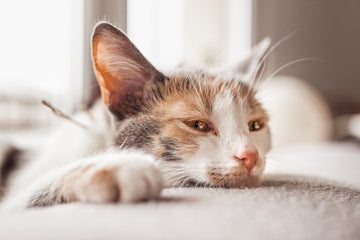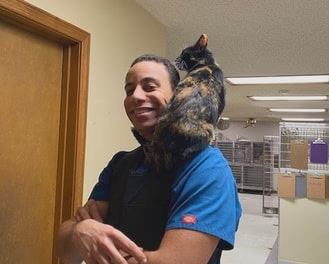8 Min Read
Panleukopenia In Cats: Symptoms, Causes & Treatment
Key takeaway

Why pet owners are switching to online vet care with Dutch
-
Prescriptions delivered free to you
-
Fast access to Licensed Vets over video
-
Unlimited video visits and follow-ups
Panleukopenia in cats is a contagious, life-threatening disease that mostly affects unvaccinated cats, including kittens who aren’t old enough to be vaccinated. Panleukopenia can be fatal if it’s not diagnosed and treated by a vet. Like canine parvovirus, panleukopenia virus in cats can cause severe distress. This article will discuss panleukopenia, including what it is, its symptoms, causes, and treatment options.
- What Is Panleukopenia In Cats?
- Symptoms Of Panleukopenia In Cats
- What Causes Panleukopenia In Cats?
- Diagnosis
- Treatment
- Panleukopenia: Frequently Asked Questions
- Final Notes
What Is Panleukopenia In Cats?
Panleukopenia in cats is an infectious disease characterized by fever, vomiting, diarrhea, and depression. Ultimately, the viral disease is highly contagious, with kittens being the most affected. Also called feline distemper and feline parvo, panleukopenia does not infect humans, so it can’t be passed from your cat to you or other humans.2 However, it can be passed from cat to cat. Panleukopenia infects cats and kills their white blood cells that are growing and dividing.1
Almost all cats and kittens are exposed to panleukopenia throughout their lives because the virus is present almost everywhere. Therefore, in the case of indoor vs. outdoor cats, all can contract panleukopenia. Cats of any age can get panleukopenia, but it typically affects immunocompromised and unvaccinated cats and kittens.2 Death from panleukopenia is most common in young cats. Any cat that comes into contact with another cat can be exposed to the virus, so it’s important to have your cat vaccinated as soon as they’re old enough to prevent any life-threatening complications.

Symptoms Of Panleukopenia In Cats
Panleukopenia has minor variations in symptoms, but cats typically experience depression, fever, and vomiting. Almost all of the signs of panleukopenia are also symptoms of many other illnesses, so it’s hard to differentiate between them. However, the intestinal tract may be affected and symptoms include frequent vomiting and diarrhea. Additionally, because the cat is unwell, their coat may become dull and rough while their gums may become tacky due to dehydration.
Cats may also develop secondary infections due to a weakened immune system. Common feline panleukopenia symptoms in cats include:
- Depression
- Lethargy
- Vomiting and diarrhea
- Dehydration
- Weight loss
- Changes in fur and skin
- Fever and collapse
- Decreased appetite
Many of the above symptoms are the first symptoms owners might notice.2 In young cats, late stages of panleukopenia can also cause brain damage.2
What Causes Panleukopenia In Cats?
Panleukopenia in cats is caused by a virus that attacks the white blood cells. Cats shed the virus through their urine, stool, and other secretions, and infection occurs when another cat comes into contact with those fluids. An infected cat sheds the virus for only one to two days, but the virus can survive in the environment much longer. Therefore, cats can get the virus by coming into contact with infected objects, including bedding, crates, toys, and food dishes.2
Cats infected with the disease should be isolated from other cats, and anything used by the infected cat, including blankets, bedding, food bowls, and even food, should not be used with other pets. Additionally, because the virus can spread from objects, individuals handling infected cats should wash their hands thoroughly before handing a healthy cat. Even though humans will not be affected by panleukopenia, they can spread it from cat to cat.
Additionally, kittens can become infected if their mothers are infected while pregnant or exposed to it after birth. For example, a kitten may come infected from drinking its infected mother’s milk.
Unfortunately, the virus cannot be killed with most disinfectants, so washing an infected cat’s belongings might not be enough to protect other cats in the home. In addition, unvaccinated cats should not be allowed near an infected cat or where they’ve been, even if the area has been clean. Instead, it’s best to keep unvaccinated cats completely separate.
Diagnosis
It’s hard for a vet to diagnose panleukopenia from symptoms alone because the symptoms associated with the illness are similar to other types of common illnesses in cats, including pancreatitis, feline immunodeficiency virus (FIV), and feline leukemia virus (FeLV).
Additionally, some infected cats can show signs related to gastrointestinal problems or even poisoning because the virus can damage the cells in the intestines. However, cats showing symptoms should be taken to the vet immediately to help rule out any other possible illnesses. A vet can diagnose a cat with panleukopenia based on their medical history and vaccination status along with blood work. Your vet will ask you questions about your cat, including whether they were recently adopted or if they’ve come into contact with other potentially infected cats. Panleukopenia is associated with low white blood cell count, so your vet might be looking for signs of low blood cells when taking a blood test.
Your vet might also try fecal testing. However, fecal testing can produce false results in cats who have recently been immunized.2
Treatment
Once your vet has diagnosed your pet, they can start to form a plan for how to treat panleukopenia in your cat. Cats younger than eight weeks are at an increased risk of death, but older cats have greater chances the sooner they get treatment.
Unfortunately, there are no medications currently available to kill the virus, but vets use a variety of techniques, including medications and fluids, to help the cat’s immune system fight the virus itself.2 Supportive care is necessary for helping cats, and without it, up to 90% of cats with panleukopenia die. Supportive care typically includes treating dehydration with fluid therapy, especially if the cat has vomiting and diarrhea.
Infected cats are at an increased risk of bacterial infections due to poor immune system function, so your cat might also be put on antibiotics. During the cat’s treatment of panleukopenia, it’s important to note any cats that may have come into contact with it while it was infected. Any cats that might be infected should be monitored for signs of illness and taken to the vet immediately if they become ill.
Again, the earlier panleukopenia is caught and treated, the better your cat’s prognosis. Cats who respond well to therapy during the first few days with the virus have a good outlook for complete recovery. Once a cat recovers, they will develop an immunity to the virus.
However, panleukopenia can be fatal for many cats, especially those that aren’t diagnosed and treated quickly. The best way to protect your cat or kitten from serious illness is to get them vaccinated. The panleukopenia vaccination is a core vaccine for cats and can give them immunity for their entire lives.
To ensure your pet is protected from the virus, they will need repeated vaccinations every one to three years, depending on the vaccination given. You can discuss your options with your veterinarian when bringing home a new cat.
How Long Does Panleukopenia Last In Cats?
How long Panleukopenia lasts in cats depends on how early they are diagnosed and their treatment. Young cats can die from the virus, while adult cats have a better prognosis. Cats that make it through treatment will fully recover within a few weeks. However, there is no specific cure, so the earlier your cat gets supportive care, the stronger their bodies will be to fight the illness.
Additionally, cats can shed the virus after they’ve been treated, so it’s important to keep them isolated during this time. Luckily, once a cat is treated for panleukopenia, they have a life-long immunity.
Panleukopenia: Frequently Asked Questions
Can a cat survive Panleukopenia?
Cats can survive panleukopenia with proper treatment. The earlier you get your cat to the vet for diagnosis, the better their prognosis. However, kittens and young cats are at an increased risk of death, even with treatment. Once a cat survives panleukopenia, they are immune for the rest of their lives.
How do I know if my cat has Panleukopenia?
There are many signs of panleukopenia, including depression, lethargy, vomiting, and diarrhea. Unfortunately, these symptoms are associated with many other types of cat illnesses. The only way to know if your cat has panleukopenia is to have them diagnosed by a vet as soon as possible so that they can begin treatment and increase the odds of a successful recovery.

Final Notes
Panleukopenia in cats is contagious. Nearly all cats will come into contact with the virus in their lifetime, but it can be fatal to kittens and unvaccinated cats. There is no medication to kill the virus, and treatment comes in the form of supportive care from the vet, which can address dehydration and help the cat’s body fight off infection.
Because panleukopenia can be fatal, prevention is key to your cat’s health. The panleukopenia vaccination is one of many core vaccines for cats, and most kittens will receive their vaccinations between the ages of six and eight weeks. The symptoms of panleukopenia may mirror another illness, so it’s important to talk to a vet if your cat begins displaying signs of illness.
Whether your cat is suffering from skin problems like a fluid-filled lump, warts, a skin tag, or a more serious illness, Dutch has your back. Dutch’s telemedicine for pets platform connects pet parents with licensed vets who can help them learn about different treatment options and medications to prevent illness in cats. With access to our resources, including vets ready to talk to you about any and all of your concerns, Dutch simplifies being a pet parent so you can spend less time worrying about your cat and more time cuddling with them.Share
References
-
Squires, Richard A. “Feline Panleukopenia - Generalized Conditions.” Merck Veterinary Manual, Merck Veterinary Manual, 1 June 2022, https://www.merckvetmanual.com/generalized-conditions/feline-panleukopenia/feline-panleukopenia.
-
“Feline Panleukopenia.” American Veterinary Medical Association, https://www.avma.org/resources-tools/pet-owners/petcare/feline-panleukopenia.
